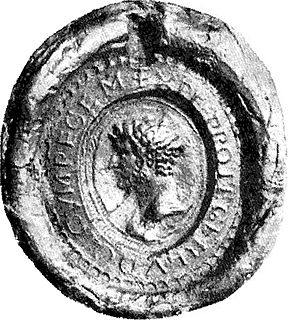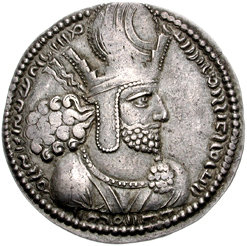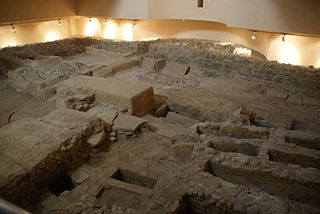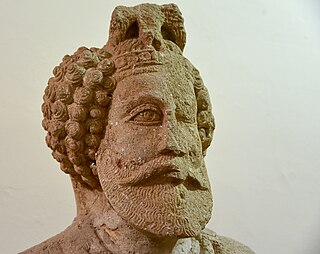An emperor is a monarch, and usually the sovereign ruler of an empire or another type of imperial realm. Empress, the female equivalent, may indicate an emperor's wife, mother, or a woman who rules in her own right. Emperors are generally recognized to be of a higher honour and rank than kings. In Europe, the title of Emperor has been used since the Middle Ages, considered in those times equal or almost equal in dignity to that of Pope due to the latter's position as visible head of the Church and spiritual leader of the Catholic part of Western Europe. The Emperor of Japan is the only currently reigning monarch whose title is translated into English as Emperor.

Louis "the German", also known as Louis II, was the first king of East Francia, and ruled from 843-876 AD. Grandson of emperor Charlemagne and the third son of emperor of Francia, Louis the Pious and his first wife, Ermengarde of Hesbaye, he received the appellation Germanicus shortly after his death in recognition of Magna Germania of the Roman Empire, reflecting the Carolingian's assertions that they were the rightful descendants of the Roman Empire

Shapur I, also known as Shapur the Great, was the second shahanshah of the Sasanian Empire. The dates of his reign are commonly given as 240/42 – 270, but it is likely that he also reigned as co-regent prior to his father's death in 242.
Cináed mac Duib anglicised as Kenneth III, and nicknamed An Donn, "the Chief" or "the Brown", was King of Scots from 997 to 1005. He was the son of Dub. Many of the Scots sources refer to him as Giric son of Kenneth son of Dub, which is taken to be an error. An alternate explanation is that Kenneth had a son, Giric, who ruled jointly with his father

Osroene, also spelled Osroëne and Osrhoene and sometimes known by the name of its capital city, Edessa, was a historical kingdom in Upper Mesopotamia, which was ruled by the Abgarid dynasty of Arab origin. It enjoyed semi-autonomy to complete independence from the years of 132 BC to AD 216, and a Roman province from 216 to 608, from 318 a part of the Diocese of the East.

The Roman provinces were the lands and people outside of Rome itself that were controlled by the Republic and later the Empire. Each province was ruled by a Roman who was appointed as governor. Although different in many ways, they were similar to the states in Australia or the United States, the regions in the United kingdom or New Zealand, or the prefectures in Japan. Canada refers to some of its territory as provinces.

The gens Julia or Iulia was one of the most ancient patrician families at Ancient Rome. Members of the gens attained the highest dignities of the state in the earliest times of the Republic. The first of the family to obtain the consulship was Gaius Julius Iulus in 489 BC. The gens is perhaps best known, however, for Gaius Julius Caesar, the dictator, and grand uncle of the emperor Augustus, through whom the name was passed to the so-called Julio-Claudian dynasty of the 1st century AD. The nomen Julius became very common in imperial times, as the descendants of persons enrolled as citizens under the early emperors began to make their mark in history.

Domitia Longina was a Roman empress and wife to the Roman emperor Domitian. She was the youngest daughter of the general and consul Gnaeus Domitius Corbulo. Domitia divorced her first husband, Lucius Aelius Lamia Plautius Aelianus in order to marry Domitian in AD 71. The marriage produced only one son, whose early death is believed to have been the cause of a temporary rift between Domitia and her husband in AD 83. She became the empress upon Domitian's accession in AD 81, and remained so until his assassination in AD 96. She is believed to have died sometime between AD 126 and AD 130.

Cunobeline was a king in pre-Roman Britain from about AD 10 until about AD 40. He is mentioned in passing by the classical historians Suetonius and Dio Cassius, and many coins bearing his inscription have been found. He appears to have controlled a substantial portion of south-eastern Britain, and is called "King of the Britons" by Suetonius. Cunobeline appears in British legend as Cynfelyn (Welsh), Kymbelinus or Cymbeline, as in the play by William Shakespeare.

Ardashir I or Ardeshir I, also known as Ardashir the Unifier, was the founder of the Sasanian Empire. He was also Ardashir V of the dynasty of the Kings of Persis, until he founded the new empire. After defeating the last Parthian shahanshah Artabanus V on the Hormozdgan plain in 224, he overthrew the Parthian dynasty and established the Sasanian dynasty. Afterwards, Ardashir called himself "shahanshah" and began conquering the land that he called Iran.

The Chera dynasty (Cēra) was one of the principal lineages in the early history of the present day states of Kerala and Tamil Nadu in southern India. Together with the Cholas of Uraiyur and the Pandyas of Madurai, the early Cheras were known as one of the three major powers (muventar) of ancient Tamilakam in the early centuries of the Common Era.

The Parthian Empire, also known as the Arsacid Empire, was a major Iranian political and cultural power in ancient Iran. Its latter name comes from Arsaces I of Parthia who, as leader of the Parni tribe, founded it in the mid-3rd century BC when he conquered the region of Parthia in Iran's northeast, then a satrapy (province) under Andragoras, in rebellion against the Seleucid Empire. Mithridates I of Parthia (r. c. 171–138 BC) greatly expanded the empire by seizing Media and Mesopotamia from the Seleucids. At its height, the Parthian Empire stretched from the northern reaches of the Euphrates, in what is now central-eastern Turkey, to eastern Iran. The empire, located on the Silk Road trade route between the Roman Empire in the Mediterranean Basin and the Han dynasty of China, became a center of trade and commerce.

The Kingdom of Commagene was an ancient Armenian kingdom of the Hellenistic period, located in and around the ancient city of Samosata, which served as its capital. The Iron Age name of Samosata, Kummuh, probably gives its name to Commagene. Commagene has been characterized as a "buffer state" between Armenia, Parthia, Syria, and Rome; culturally, it seems to have been correspondingly mixed. The kings of the Kingdom of Commagene claimed descent from Orontes with Darius I of Persia as their ancestor, by his marriage to Rodogoune, daughter of Artaxerxes II who had a family descent from king Darius I. The territory of Commagene corresponds roughly to the modern Turkish provinces of Adıyaman and northern Antep.

Ad Septem Fratres, usually shortened to Septem, was a Roman colony in the province of Mauretania Tingitana and a Byzantine outpost in the exarchate of Africa. It was located within present-day Ceuta, Spain, in northwest Africa.
Sanatruq II (snṭrwq) was the last king of Hatra, ruling from about AD 200 to 240/41. He was the son of king Abdsamiya and is attested by nine inscriptions discovered at Hatra. Only two of these inscription bear year datings, both are hard to read.(perhaps 231 and 237/38) Sanatruq II appears in Syrian sources as Sanatru and in Arab sources as Daizian and Satirun. One of his inscriptions was found on a statue showing him standing. His wife was perhaps Abbu. There are two sons known. Abdsamiya was named after his grandfather. He was his heir. Another son, Mana is attested in year 235 and seems to had Arabia of Wal under his control. This is a region southeast of Edessa. From the latter evidence it seems that Sanatruq II expanded his territory. The daughter Duspari is known from a statue, dated to year 549. As second statue belongs to her daughter Samay.
Abdsamiya was a king of Hatra, an ancient city and kingdom in ancient Mesopotamia (Iraq). He reigned from about AD 180 to 205. Abdsamiya was the son of king Sanatruq I and the father of Sanatruq II. Abdsamiya is known from eight inscriptions found at Hatra. One of them reports the building of a porticus for the king and is dated to year 504 of the Seleucid era. Another inscription appears on a statue and is dated to AD 201/202. Abdsamiya is most likely also mentioned by Herodian (3.1.3). There he appears as Barsemias. He supported in year AD 192 Pescennius Niger against Septimius Severus.

Sanatruq I was a king of Hatra, an ancient city in nowadays Iraq. He is known from more than 20 inscriptions found at Hatra and reigned from about AD 140 to 180. Only one of his inscriptions is dated. He was the son of Naṣru who reigned from about AD 128 to 140. He was one of the first rulers of Hatra calling himself mlk (king), but he bears also the title mry' (administrator). Both titles are also attested for his brother Vologash or Wolgash. It is unclear whether they both reigned together and took of the title king at some point in their reign, or whether Sanatruq succeeded Wolgash. His son and successor was Abdsamiya.

The fall of Hatra, capital of the Kingdom of Araba under Sanatruq II, took place in the 3rd century after a lengthy siege by the Sasanian king Shapur I. Hatra was plundered and abandoned, and its kingdom dissolved.















